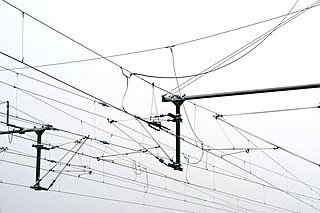
An overhead line or overhead wire is an electrical cable that is used to transmit electrical energy to electric locomotives, trolleybuses or trams. The generic term used by the International Union of Railways for the technology is overhead line. It is known variously as overhead catenary, overhead contact line (OCL), overhead contact system (OCS), overhead equipment (OHE), overhead line equipment, overhead lines (OHL), overhead wiring (OHW), traction wire, and trolley wire.

A transmission tower is a tall structure, usually a lattice tower made of steel that is used to support an overhead power line. In electrical grids, transmission towers carry high-voltage transmission lines that transport bulk electric power from generating stations to electrical substations, from which electricity is delivered to end consumers; moreover, utility poles are used to support lower-voltage sub-transmission and distribution lines that transport electricity from substations to electricity customers.

The Kontek HVDC is a 170-kilometre (110 mi) long, monopolar 400 kV high-voltage direct current cable between Germany and the Danish island Zealand. Its name comes from "continent" and the name of the former Danish power transmission company "Elkraft", which operated the power grid on the Danish islands Lolland, Falster and Zealand and had the abbreviation "ek". As of today, the cable is operated by Energinet.dk in Denmark and 50Hertz Transmission GmbH in Germany.

The Baltic Cable is a monopolar HVDC power line running beneath the Baltic Sea that interconnects the electric power grids of Germany and Sweden. Its maximum transmission power is 600 megawatts (MW).
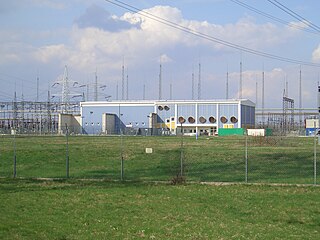
The GK Vienna–Southeast was a back-to-back HVDC station linking the electric power grids of Austria and Hungary. It operated between June 1993 and October 1996.

The Pylons of Messina are two free-standing steel towers, the Sicilian one in Torre Faro and the Calabrian one in Villa San Giovanni. They were used from 1955 to 1994 to carry a 220 kilovolt power line across the Strait of Messina, between the Scilla substation in Calabria on the Italian mainland at 38°14′42″N15°40′59″E and the Messina-Santo substation in Sicily at 38°15′57″N15°39′04″E.

An overhead power line is a structure used in electric power transmission and distribution to transmit electrical energy along large distances. It consists of one or more conductors suspended by towers or poles. Since most of the insulation is provided by air, overhead power lines are generally the lowest-cost method of power transmission for large quantities of electric energy.
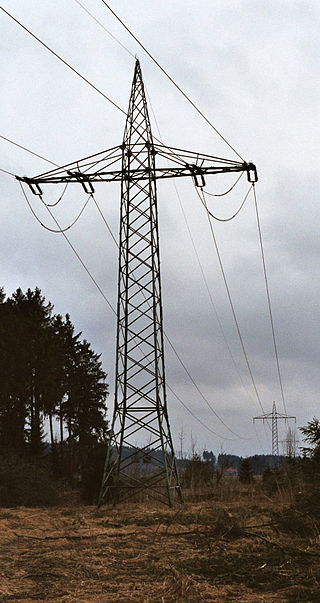
A traction network or traction power network is an electricity grid for the supply of electrified rail networks. The installation of a separate traction network generally is done only if the railway in question uses alternating current (AC) with a frequency lower than that of the national grid, such as in Germany, Austria and Switzerland.
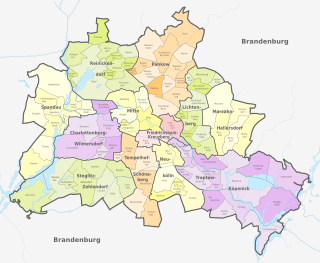
Berlin is both a city and one of Germany's federated states. Since the 2001 administrative reform, it has been made up of twelve districts, each with its own administrative body. However, unlike the municipalities and counties of other German states, the Berlin districts are not territorial corporations of public law with autonomous competencies and property, but simple administrative agencies of Berlin's state and city government, the City of Berlin forming a single municipality since the Greater Berlin Act of 1920. Thus they cannot be equated to US or UK boroughs in the traditional meaning of the term.
TenneT is a transmission system operator in the Netherlands and in a large part of Germany.

GKK Etzenricht, an abbreviation of Gleichstromkurzkupplung Etzenricht, meaning Etzenricht HVDC-back-to-back station, was an HVDC back-to-back facility near Etzenricht in the district of Neustadt an der Waldnaab in Bavaria, Germany. It was built on the site of the Etzenricht substation, a 380 kV/220 kV/110 kV-substation, which went into service in 1970 and expanded afterwards several times. The facility was used between 1993 and 1995 for the exchange of power between Germany and the Czech Republic, operated by Bayernwerk AG.

CEPCO is a construction company with corporate headquarters in Jeddah, Saudi Arabia, with offices throughout Saudi Arabia and in Middle East. CEPCO has been in business since 1977 and provides construction services in the fields of Civil & Infrastructure, Electrical, Horizontal Directional Drilling, Electromechanical, Oil, Gas & Power.

50Hertz Transmission GmbH, formerly named Vattenfall Europe Transmission, is one of four transmission system operators for electricity in Germany, and is wholly owned by Eurogrid GmbH, indirectly owned and managed by the Belgian transmission system operator Elia System Operator and Australian-based IFM Investors. The company is a member of the European Network of Transmission System Operators for Electricity (ENTSO-E).
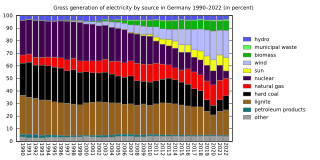
Germany's electrical grid is part of the Synchronous grid of Continental Europe. In 2020, due to COVID-19 conditions and strong winds, Germany produced 484 TW⋅h of electricity of which over 50% was from renewable energy sources, 24% from coal, and 12% from natural gas. This is the first year renewables represented more than 50% of the total electricity production and a major change from 2018, when a full 38% was from coal, only 40% was from renewable energy sources, and 8% was from natural gas.
Powerline river crossings comprise both overhead lines and cable tunnels beneath rivers and estuaries. Overhead power lines are supported on towers which are usually significantly taller than overland pylons and are more widely spaced to cross the river in a single span. Tall pylons ensure that the electricity cables which they support provide an adequate safety clearance for river traffic.
Viking Link is a 1,400 MW HVDC submarine power cable nearing completion between the United Kingdom and Denmark.
The Lower Lea Valley Cable Tunnels, known as the PLUG Project during construction, are a pair of 6 km cable tunnels running beneath the lower Lea Valley in east London. Constructed at a cost of £130m ahead of the 2012 London Olympic Games, they are owned by National Grid plc and UK Power Networks.
The River Medway Cable Tunnels are a pair of tunnels carrying high-voltage electricity transmission lines beneath the lower River Medway between the Isle of Grain and Chetney Marshes, Kent.
The Severn-Wye Cable Tunnel, also known as the Severn Cable Tunnel, carries high-voltage electricity transmission lines beneath the estuaries of the River Severn and River Wye between Newhouse (Mathern), Monmouthshire and Aust, South Gloucestershire.















